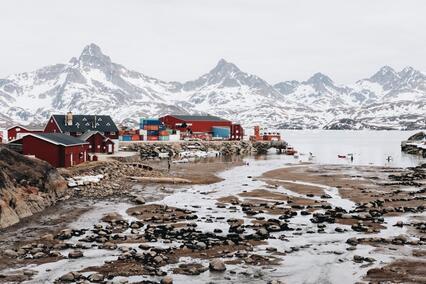|
In the winter of 2017-2018, I had the wonderful opportunity to spend a month in India (in better days) with the primary purpose of attending an international conference on World Heritage Sites and nature conservation. On the way back, my flight from Delhi to Denver routed through Heathrow in London. As it happens, this route traverses extraordinarily far north over Greenland, Baffin Island and Hudson Bay in Canada. My trip to balmy India thus turned remarkably into a scenic flight over the Arctic in the dead of winter.
By an accident of timing, the entire flight was in daylight as we raced ahead of the sun, while the weather was remarkably clear. Northern Ireland and Scotland peeked out of the fog, eastern Greenland was sealed in a layer of cloud, but before long I caught glimpses of Greenland’s ice sheet and massive maritime glaciers and black cliffs. The sea ice of Hudson Bay seemed to stretch on forever. At times, the ice appeared in great solid peninsulas, and at other times it had an odd texture like a frog’s skin or paint chips tightly scattered across the sea. I could only imagine how large each of those chips really was. This wasn’t mere daylight, but the perpetual light of a winter sunset—the white expanse reflected a soft orange glow. For thousands of miles. I stared out the window in awe of this immense frozen landscape. As it happened, one of the inflight movie options was a Red Bull documentary entitled Into Twin Galaxies about a small group of explorers who kite-skied across Greenland’s ice cap to access a remote whitewater river. I took turns watching it and gawking out the window. I knew I had to go. Not just for adventure, but because I was convinced of Greenland’s central importance in the world’s future. And that it was an exceptionally beautiful place that I just had to see for myself. This three-and-a-half-year-old vision is finally coming to fruition this summer. I am due to arrive in Greenland in two weeks with the purpose of working on two amazing projects. The first is a NEST (Nature, Environment, Science, and Technology) Studio for the Arts project with the primary purpose of bridging art and science through writing and photography (https://www.facebook.com/nestcuboulder/). Based on my time in Greenland and a previous trip to Nepal, I will put together an exhibit with the assistance of two PhD students specializing in glacial science (and possibly a helpful friend or two) that will hopefully go on display this winter in Boulder. The second project is a Pulitzer Center environmental journalism grant focused on the relationship between the U.S. and Greenland in the context of climate change, with an additional focus on the science taking place on Greenland’s glaciers and ice sheets. I have a nice website for this and just wrote my first post: https://pulitzercenter.org/projects/legacy-us-relations-greenland-era-climate-change. Please check it out. I hope also to do a little adventuring on glaciers, rivers, or seas. I plan to post intermittent updates and photos on Facebook, Instagram (https://www.instagram.com/Chrisdunnonplanetearth/), and here on my blog.
0 Comments
I'm excited to announce that I'll be participating in the American Climber Science Program's 2019 Lhotse/Everest expedition in Nepal this March-June. We will be conducting research in Sagamartha and Makalu Barun National Parks, where we will attempt to summit Lhotse, Everest's slightly shorter 27,940 foot next door neighbor. A separate team will attempt Everest.
Check here for updates, descriptions of our team and our research: https://www.climberscience.org/blog https://www.climberscience.org/nepal I expect it to be the hardest thing I've ever done, but I'm looking forward to it. I hope it is a fruitful research project. |
Chris Dunn, PhD
Researcher, writer, explorer*, photographer, thinker. Wrestling with nature, culture, technology. Archives
July 2024
Categories
All
*When I use the term "exploration", I mean it in a personal sense (discovery for myself, or at a unique moment in time [everywhere after all--even crowded cities--endlessly await rediscovery--by new eyes and in new moments]), not in an absolute sense. With few exceptions (notably Antarctica), almost everywhere on earth has had other people around for a long time (though to varying degrees - high mountain tops or places like the interior of the Greenland Ice Sheet for instance were far less visited and populated, and undoubtedly at least some pockets of the earth were never visited or populated). It is an enlightening experience though when on an isolated ridge in what feels like the middle of nowhere to wonder if anyone has set foot there but never knowing for sure. What is significant is that the landscape itself is left in such a condition that it isn't evident. Some places ought to be kept that way.
|

 RSS Feed
RSS Feed